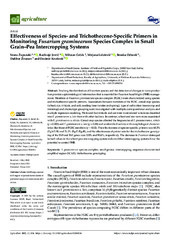Приказ основних података о документу
Effectiveness of species and trichothecene specific primers in monitoring Fusarium graminearum species complex in small grain pea intercropping systems
| dc.creator | Župunski, Vesna | |
| dc.creator | Jevtić, Radivoje | |
| dc.creator | Grčak, Milosav | |
| dc.creator | Lalošević, Mirjana | |
| dc.creator | Orbović, Branka | |
| dc.creator | Živanov, Dalibor | |
| dc.creator | Knežević, Desimir | |
| dc.date.accessioned | 2023-05-18T10:09:26Z | |
| dc.date.available | 2023-05-18T10:09:26Z | |
| dc.date.issued | 2022 | |
| dc.identifier.issn | 2077-0472 | |
| dc.identifier.uri | http://fiver.ifvcns.rs/handle/123456789/3566 | |
| dc.description.abstract | Tracking the distribution of Fusarium species and the detection of changes in toxin production provides epidemiological information that is essential for Fusarium head blight (FHB) management. Members of Fusarium graminearum species complex (FGSC) were characterized using species and trichothecene-specific primers. Associations between members of the FGSC, cereal crop species (wheat, rye, triticale, and oat), seeding time (winter and spring), type of cultivation (monocrop and intercrop) and chemotype grouping were investigated with multiple correspondence analysis and multiple regression modeling. We found that triticale and oat were more related to isolates classified into F. graminearum s. lato than with other isolates. In contrast, wheat and rye were more associated with F. graminearum s. stricto. Cereal crop species affected the frequencies of F. graminearum s. stricto (p = 0.003) and F. graminearum s. lato (p = 0.08) and unidentified isolates with morphological characteristics like those of FGSC members (p = 0.02). The effectiveness of species-specific primers was 60.3% (Fg16F/R) and 76.2% (FgrF/FgcR), and the effectiveness of primer sets for the trichothecene genotyping of the Tri5 and Tri3 genes was 100% and 90.6%, respectively. The decrease in Fusarium-damaged kernel values in the wheat–pea intercropping system indicated that intercropping systems have the potential to control FHB. | sr |
| dc.language.iso | en | sr |
| dc.publisher | Basel : MDPI | sr |
| dc.relation | info:eu-repo/grantAgreement/MESTD/inst-2020/200032/RS// | sr |
| dc.rights | openAccess | sr |
| dc.rights.uri | https://creativecommons.org/licenses/by/4.0/ | |
| dc.source | Agriculture | sr |
| dc.subject | Fusarium | sr |
| dc.subject | graminearum | sr |
| dc.subject | species | sr |
| dc.subject | complex | sr |
| dc.subject | small | sr |
| dc.subject | grains | sr |
| dc.subject | intercropping | sr |
| dc.subject | sequence | sr |
| dc.subject | characterized | sr |
| dc.subject | amplified | sr |
| dc.subject | region | sr |
| dc.subject | SCAR | sr |
| dc.subject | genotyping | sr |
| dc.subject | trichothecene | sr |
| dc.title | Effectiveness of species and trichothecene specific primers in monitoring Fusarium graminearum species complex in small grain pea intercropping systems | sr |
| dc.type | article | sr |
| dc.rights.license | BY | sr |
| dc.citation.epage | 14 | |
| dc.citation.rank | M21 | |
| dc.citation.spage | 834 | |
| dc.citation.volume | 12 | |
| dc.identifier.doi | 10.3390/agriculture12060834 | |
| dc.identifier.fulltext | http://fiver.ifvcns.rs/bitstream/id/9505/agriculture-12-00834-v2.pdf | |
| dc.identifier.scopus | 2-s2.0-85132306118 | |
| dc.identifier.wos | 00081840600000 | |
| dc.type.version | publishedVersion | sr |


